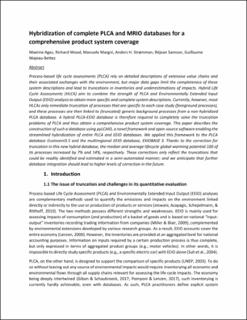| dc.contributor.author | Agez, Maxime | |
| dc.contributor.author | Wood, Richard | |
| dc.contributor.author | Margni, Manuele | |
| dc.contributor.author | Strømman, Anders Hammer | |
| dc.contributor.author | Samson, Réjean | |
| dc.contributor.author | Majeau-Bettez, Guillaume | |
| dc.date.accessioned | 2021-02-12T11:55:27Z | |
| dc.date.available | 2021-02-12T11:55:27Z | |
| dc.date.created | 2020-09-29T13:30:23Z | |
| dc.date.issued | 2020 | |
| dc.identifier.citation | Journal of Industrial Ecology. 2020, 24 (4), 774-790. | en_US |
| dc.identifier.issn | 1088-1980 | |
| dc.identifier.uri | https://hdl.handle.net/11250/2727735 | |
| dc.description.abstract | Process‐based Life Cycle Assessments (PLCA) rely on detailed descriptions of extensive value chains and their associated exchanges with the environment, but major data gaps limit the completeness of these system descriptions and lead to truncations in inventories and underestimations of impacts. Hybrid Life Cycle Assessments (HLCA) aim to combine the strength of PLCA and Environmentally Extended Input Output (EEIO) analysis to obtain more specific and complete system descriptions. Currently, however, most HLCAs only remediate truncation of processes that are specific to each case study (foreground processes), and these processes are then linked to (truncated) generic background processes from a non‐hybridized PLCA database. A hybrid PLCA‐EEIO database is therefore required to completely solve the truncation problems of PLCA and thus obtain a comprehensive product system coverage. This paper describes the construction of such a database using pyLCAIO, a novel framework and open‐source software enabling the streamlined hybridization of entire PLCA and EEIO databases. We applied this framework to the PLCA database Ecoinvent3.5 and the multiregional EEIO database EXIOBASE 3. Thanks to the correction for truncation in this new hybrid database, the median and average life cycle global warming potential (GWP) of its processes increased by 7% and 14%, respectively. These corrections only reflect the truncations that could be readily identified and estimated in a semi‐automated manner; and we anticipate that further database integration should lead to higher levels of correction in the future. | en_US |
| dc.language.iso | eng | en_US |
| dc.publisher | Wiley | en_US |
| dc.title | Hybridization of complete PLCA and MRIO databases for a comprehensive product system coverage | en_US |
| dc.type | Peer reviewed | en_US |
| dc.type | Journal article | en_US |
| dc.description.version | acceptedVersion | en_US |
| dc.source.pagenumber | 774-790 | en_US |
| dc.source.volume | 24 | en_US |
| dc.source.journal | Journal of Industrial Ecology | en_US |
| dc.source.issue | 4 | en_US |
| dc.identifier.doi | 10.1111/jiec.12979 | |
| dc.identifier.cristin | 1834911 | |
| dc.description.localcode | This is the peer reviewed version of an article, which has been published in final form at https://doi.org/10.1111/jiec.12979. This article may be used for non-commercial purposes in accordance with Wiley Terms and Conditions for Self-Archiving. | en_US |
| cristin.ispublished | true | |
| cristin.fulltext | postprint | |
| cristin.qualitycode | 2 | |
